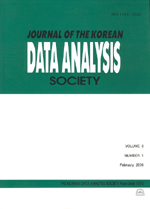간호대학생의 학습유형, 시각화 경향성, 문제해결과정과의 관계
The Relationship between Learning Style, Visualization Tendency and Problem-solving Process among Nursing Student
- 한국자료분석학회
- Journal of The Korean Data Analysis Society (JKDAS)
- Vol.23 No.5
-
2021.102351 - 2363 (13 pages)
-
DOI : 10.37727/jkdas.2021.23.5.2351
- 127

본 연구의 목적은 간호대학생의 학습유형, 시각화 경향성, 문제해결 과정간의 관계를 조사하는 것이다. 연구방법은 232명의 간호대학생을 편의 수집 하였으며 구조화된 설문지를 이용하여 자료수집하였다. 수집된 자료는 평균, 표준편차, 백분율, independent samples t-test, ANOVA, Pearson s correlation coefficient, logistic regression을 사용하여 분석하였다. 일반적 특성에 따른 시각화 경향성 정도는 통계적으로 유의미하지 않았고, 대상자의 학습유형은 적응형이 122명(54.5%)으로 가장 많았으며 확산형(49명, 21.9%), 동화형(37명, 16.5%), 수렴형(16명, 7.1%)순으로 나타났다. 확산형이 적응형에 비해 시각화 경향성 점수가 높았고 (F=5.75, p=.001) 확산형과 동화형이 적응형에 비해 문제해결과정 점수가 높았다 (F=5.42, p=.001). 시각화 경향성과 문제해결과정간에는 양의 상관관계가 있었으며(r=.49, p<.001), 로지스틱 회귀분석에서 시각화 경향성이 가장 높은 그룹이 가장 낮은 그룹에 비해 문제해결과정 점수가 높을 가능성이 17.24배 높았다(OR = 17.24, 95% Confidence Interval = 3.79~78.40). 본 연구결과는 간호대학생의 학습유형을 고려한 교수법활용과 문제해결능력을 높이기 위해 시각화 경향성을 활용한 교수법 적용이 필요함을 시사한다.
This study was conducted to investigate the relationship between learning style, visualization tendency, and problem-solving process among nursing student. Participants included 232 nursing students from one college, using convenience sampling method. The collected data was analyzed using the IBM SPSS Statistics 22.0 Program, through independent samples t-test, ANOVA, Scheffe test, Pearson s correlation coefficient, and logistic regression. As a result, a difference was found in diverging learning style and accommodating style according to the visualization tendency (F=7.75, p=.001). There was also difference in assimilating and accommodating according to the problem-solving process (F=5.42, p=.001). Visualization tendency was related to problem-solving process positively (r=.49, p<.001). A logistic regression analysis showed that students with visualization tendency in the top quartile group more likely presented with high score of problem-solving process (OR=17.24, 95%CI: 3.79~78.40), compared to nursing students in the lowest quartile. These findings provide the evidence of using visualization tendency as one of the helpful teaching-learning methods. To maximize the problem-solving process, educators must use the visualization tendency more concrete and active.
1. 서론
2. 연구방법
3. 연구 결과
4. 논의
5. 결론 및 제언
References
(0)
(0)